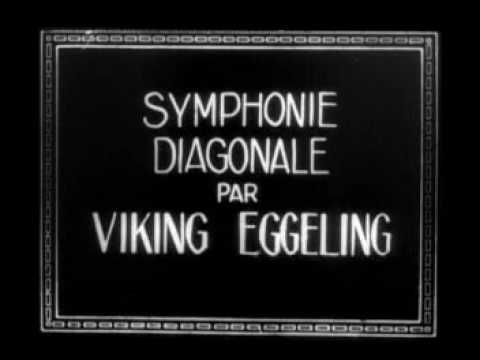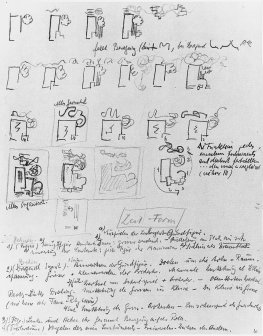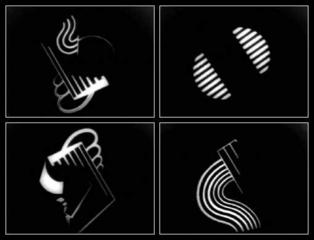|
An Excerpt from The History of Motion Graphics:
The abstract films produced by Viking Eggeling (1880 1925) and Hans Richter (1888 1976) between 1920 and 1926, unlike the work of Ruttmann, begin withand steadily explorea geometric formal language. Both Richter and Eggeling were working on similar problems and arriving at similar solutions when they met in 1918; however, Eggeling had made more progress in the development of a systematic abstraction. The initial version of this language was being developed independently by Eggeling in his paintings, and theoretically as the Generalbass der Malerei, (1918, Bassline Painting); a more formal version would be published as a pamphlet in 1920 under the title Universelle Sprache (Universal Language). Their relationship was discussed by Laszlo Moholy-Nagy in his book Painting Photography Film written in 1924, and published in 1925:
In Eggelings hands the original color-piano became a new instrument which primarily produced not color compositions but rather the articulation of space in motion. Hi pupil Hans Richter hasso far only theoreticallyemphasized the time-impulse even more strongly and has thus come near to creating a light-space-time continuity in motion.
[Laszlo Moholy-Nagy, Painting Photography Film, translated by Janet Seligman(Cambridge: MIT Press, 1987) p. 21.]
The connections between the synaesthetic dimensions of abstraction, the geometric work of Constructivism and its transition from being a live instrument to being an animated creation shown on film are explicit in Moholy-Nagys comments. It is also significant that his contemporary description produced at the time when Eggeling was completing Symphony Diagonale (and Richter was working on Rhythmus 23) recognizes that Eggelings film closely resembles the theory they had developed and Richters does not. It suggests their collaboration, begun by 1919, ended by 1921, and the joint statement titled Universelle Sprache (Universal Language) published as pamphlet in 1920 may have been more Eggelings work than Richters; since Eggeling died in 1925, leaving Richter to promote and disseminate their work, the true nature of their collaboration is unknown.
There are no known copies of the original pamphlet about their Universelle Sprache, but Richter produced several variants of this text over the span of his career, developing and reiterating its ideas. It is uncertain how much these later versions are representative of what Eggeling initially developed, or how closely Richters later versions correspond to their joint theorization. The role of time in this construction is effectively independent of the movement of the formsit is instead the duration (length of time) required to look at the completed piece. It is this separation of the conception of time from the running-time of the motion picture that presents the overlap between the static imagery of the painted image and the kinetic imagery, evolving through apparent motion, in their films. Richter explains their system:
This pamphlet elaborated our thesis that abstract form offers the possibility of a language above and beyond all national language frontiers. The basis for such language would lie in the identical form perception in all human beings and would offer the promise of a universal art as it had never existed before.
[Hans Richter, "My Experience with Movement in Painting and in Film," in The Nature and Art of Motion, ed. Gyorgy Kepes (New York: George Brazillier, 1965), p. 144.]
The appendix to Stephen Fosters anthology Hans Richter includes a facsimile of one version of this proposed formal language. The collection of papers, scrap envelops and diagram pages enumerates a graphic system based on relative scale of forms, their repetition/variation over time, and their organization in time. The individual diagrams present blocks and lines organized iconically, as are the forms clustered and linked together in the scroll-paintings that helped shape this theory. The role of color receives consideration within this construction as a means to organize groups of forms, (thus reinforcing their iconic aspects), but does not play a major role otherwise.

The synaesthetic dimensions noted by Moholy-Nagy are apparent in Eggelings initial creation in both the namebassline painting, a reference to the basso continuo in musicand in how the elements of this visual language show the common influence of the synaesthetic forms common to early abstraction. Its focus was on painted imagery, not motion pictures. These works were created as scrolls where individual images would repeat different elements in a sequence down the length of the sheet. Their graphic language employed a limited vocabulary of simple, planar geometry. This systematic development of a visual syntax modeled on language connects their theoretical work to that of the Constructivists, whose graphic work their imagery resembles.
In Richters description, where music appears as a reference, it is via analogyprincipally rhythmic and structural, not synaesthetic. The movement he describes, thus, is not simply the motion of forms in film; it is based on an analogy to movement in music, where the organization of a complex work is broken into sequences that are self-contained:
Each movement must be able to exist in itself, i.e. it must be completed, a world of its own...and open for the next/imply the next
[Hans Richter quoted by Justin Hoffman, Hans Richter: Constructivist Filmmaker, in Hans Richter: Activism, Modernism and the Avant-Garde, ed. Stephen C. Foster, (Cambridge: MIT Press, 1998) p. 76.]
The exist in itself of this notion of movement shows a different conception, one that necessarily evokes the musical analogy. This dimension of the universal language is a reminder of their basis for it in the graphic drawings and painting produced prior, during and after their experiments with film. While the synaesthetic dimension may be unclear, the impact of the systems foundations in Richter and Eggelings scroll-paintings is clear: their Universelle Sprache is first a graphic language, then secondarily a language of kinetic graphics.

elements of Eggeling's Universelle Sprache
The transition from scroll painting to cinema was a natural progression; the visual form of the scroll paintings already resembles the laid-out frames of the motion picture, where each drawing suggests the individual sampled movement contained in a film. Having started working on adapting the Universelle Sprache to film in 1920, initially both artists used their scroll paintings as the model for a corresponding film. But the initial works chosen to animateEggelings Horizontal-Vertikal Orchester (aka Horizontal Vertikal Mass) and Richters Praludium (both 1919)presented a novel problem the static medium of painting did not have: movement. Their earlier work was concerned with the relationship between the space of the image and the time needed to look at it. It was more an issue of linking forms with a gradually cumulative process. They moved from a painterly question to a cinematic one of movement that incorporated time. But the problems of animation immediately confronted their translation of graphic sequence to cinema, and both Eggeling and Richter encountered difficulties in translating their formal language to motion. Eggelings first attempt, based on his scroll-painting Horizontal-Vertical Orchester was abandoned by 1921 when his collaboration with Richter ended and he moved to Berlin; this first attempt at animating a scroll-painting is now lost. Produced over a four year period from 1921 to 1924, Eggeling adapted another scroll-painting Symphonie Diagonale into a film of the same title; similarly, Richters attempt to animate his scroll-painting, Praludium, was also abandoned without being completed; however, for his second attempt, Richter did not adapt a scroll-painting to film, and instead used a different approach to animate Rhythmus 21he would later reuse parts of his first film in Rhythmus 23.
Eggeling worked on adapting the formal language to film from 1920 to 1924, attracting the attention of Werner Grief while Grief was still a student at the Berlin Bauhaus, (a meeting that eventually lead to his writing two pieces for the De Stijl magazine inspired by Eggelings work). Graff introduced Eggeling to another Bauhaus student, Erna Niemeyer, who left the Bauhaus to assist with the film production of Symphonie Diagonale in 1923. They animated his scroll painting by making an exact copy of the forms on aluminum laminated to paper, creating an optically-opaque black except where the shapes had been cut out. This technique worked well for Eggeling since his imagery was composed of linear elements: lines and curves, not solid planes. This organization enabled a dynamic construction where his linear shapes could develop and oppose one another both graphically and rhythmically, and by setting his motions oppositionally: a movements would be mirrored in the opposite direction. Eggeling explained this repetition and opposition as pairing, and symmetry it produced was a feature of how his language developed the diagonal as a central motif.
In spite of the initial difficulties he encountered, Eggelings Symphonie Diagonale, shows a clear translation of the formal language into film: composed from a collection of elaborate black and white linear forms whose appearance on screen follows a rigid designgeometric shapes organized following the design of the scroll paintingsare gradually revealed on screen at an even pace. These visual shapes transform rather than move, the alterations appearing on screen as the revelation of iconic forms, not the kinetic action of shapes moving through space: it is a static animation, one where form unfolds, but the spatial aspects of motion remain muted and under employed compared to other abstract films such as those by Walther Ruttmann. The emergence of these forms does not entail a graphic interplay between positive and negative space, or even motion on the screen, so much as the gradual revelation of the composed designs: striations, grids, and radiating lines built around simple, symmetrical forms (circle, square, triangle), arranged into composite structures whose groupings resemble graphic crescendos and decrescendos. 
stills from Symphonie Diagonale (1924)
The final, completed Symphonie Diagonale first screened on November 5, 1924 at the Gloria Palast in Berlin to a private audience of 30 that included Laszlo Moholy-Nagy and film critic Paul F. Schmidt, who reviewed it; the first public screening was organized by the Novembergruppe six months later, on May 3, 1925; Eggeling died sixteen days following its public premiere. This public exhibition included many of the other Dada filmsBallet Mécanique, Entracteand works by Ruttmann and Richter.
|

|